
Kenji Kojima / 小島健治
Show: Biography (English & 日本語) & Artist Statement
Kenji Kojima Resume
Hide: Kenji Kojima's Biography & Artist Statement
Kenji Kojima's Biography
Kenji Kojima was born in Japan. He moved to New York in 1980 and began his artistic career. For the first 10 years in New York City, he painted contemporary egg tempera paintings using medieval art materials and techniques. He was strongly attracted to contemporary art but felt stuck in the future of modern civilization and art with material value. He tried to experience the history of the creation of the European concept of art through actual materials and techniques, that is, the history of art that is not written in literature. He was particularly interested in the basic materials of painting, such as ground, pigment, and medium, rather than the visual theme. He noticed that as society developed, people's minds expanded, materials and tools advanced, and the visual arts changed. Citibank, Hess Oil, and others have collected his egg tempera paintings.
The personal computer improved rapidly during the 1980s. He felt more comfortable with computer art than paintings. Ecologically, he had felt guilty about wasting materials in the name of art. Working on the computer was clean, did not waste material, and made him feel lighter. In the early 1990s, he moved his artwork into the digital arts. He was particularly interested in developing interactive artworks. His early digital works were archived at the New Museum - Rhizome, New York. He studied computer programming himself. In 2007, he developed the computer software "RGB MusicLab" and created an interdisciplinary artwork that explores the relationship between images and music. He developed interactive software for his art but soon ran into a big problem. the software would not run on the new operating systems. He shot the artwork to video while the software ran on the operating system. He started making videos, not only about programming art but also about ecological issues in art by shooting videos. His digital art series has been shown at media art festivals worldwide, including Europe, South America, the Middle East, Asia, and the USA.
After COVID-19, he could not go out to shoot a video, but he found numerous archival artworks online. He launched a new series titled "The Musical Interpretation of Paintings" which transforms classical image data such as paintings, photographs, and films into music. Artist Kojima believes that the sensory organs construct the world by extracting only certain components from the chaos, such as visual and auditory information, like a filter. So we create our world with the "key" of the sensory organs as if we were deciphering a code. In 2023, "Bitwise Splitting and Merging of Pixels" began with the self-question, "With the development of generative AI, can we create visual art that is not an assemblage of past visual data? Currently, all media is recorded in binary form. This fact leads to the manipulation of color pixels using bitwise operations. He created encryption-decryption projects like "The Da Vinci Code" and others. In 2024 he started an Anthropocene and ecological participatory video art project called "This Planet is Our Home".
Resume
小島健治 略歴
日本生まれ。コンピューターを使用した、知覚・認識・時間の関連を探求するアートをニューヨーク市で続けています。ニューヨークに住み始めた1980年からほぼ10年間は、ビザンチンから初期ルネッサンスの技法エッグ・テンペラで現代絵画を描き、シティバンク、ヘス石油等のコレクションになりました。その頃コンピュータは急速な発展を遂げ、90年代始めからデジタルにアートの可能性をより感じてスイッチしました。20世紀の主なデジタル作品は、ニューヨーク市ニューミュージアム(Rhizome)にアーカイブとして保存されました。2007年コンピュータ・アプリケーション「RGB MusicLab」を開発。RGBミュージックは、画像のカラーデータをアルゴリズムで音楽に変換するプロジェクトです。これはコンピュータ・データに基づいて、視覚と聴覚の境界を探求するアートです。2014年にプロジェクト・タイトルを「Techno Synesthesia(テクノ共感覚)」と改め、ビデオの時間軸からの音楽変換を始めました。プロジェクトはニューヨーク市の個展、世界各地のメディア・フェスティバル(ヨーロッパ・ブラジル・中東・日本以外のアジア)、オンライン・エキジビション等で展示されました。福島原発事故の報道写真を音楽に変換して、時間軸に編集した「コンポジション福島2011(日本未公開)」は、世界各地のメディア・フェス等で公開され、アートビデオ・ケルンのトラウマフィルム・コレクションに保存されています。ビデオ撮影ができなくなったコロナ以降素材をネット上に求めてプロジェクト「古典絵画から音楽」開始。 使用するプログラミング言語は LiveCode。
Artist Statement
I have been thinking the sense of visual and audio has strong connections. Some people believe the painter Wassily Kandinsky was a synesthesia artist. But I have a suspicion whether he had synesthesia abilities or not. Artistic intuition is important, but the ability of synesthesia is too uncertain. Despite that, I thought the sense of vision and the sense of hearing might have common areas. A composer Alexander Scriabin tried another way. He composed the symphony "Prometheus: Poem of Fire" in 1910. He imagined a symphony of sound combined with a symphony of light. He made his system which was the 12-color circle. The top of the color circle was Red and C. Each color was assigned to 12 keys. The idea was based on Isaac Newton's color wheel. He wrote the light (luce) part of the score by musical notations in the symphony. However, his vision did not realize the technological limits of his own time. 100 years later, the performance of his work was realized by recent technologies. Composer Scriabin explored the common information of visual and auditory with the art of different expressions.
I was more interested in Scriabin's method than in using intuition for synesthesia art. We can use computer technology in the 21st century. I developed an algorithmic composition program "RGB MusicLab" in 2007 that converted computer color data to 12-tone notes. The color value 120 is the middle C on a musical scale. Also, I found binary is a new art material. The current project "Techno Synesthesia" is based on RGB Music technology.
A cyborg is a radical evolution of physical extension that uses science and technology in the 21st century. We have evolved extremely slowly to recognize the surrounding environment through sensory organs such as visual, auditory, tactile, and others, and realize them as reality. However, we do not know how we perceive our environment, the boundaries of sensory information, and how we handle them and choose our actions. What was the difference between humans and deep-sea creatures that have evolved to distinguish information from the outside world? The project "Techno Synesthesia" inherits the predecessors and experiments with the fusion and compatibility of multiple sensory organs by computer technology.
The Infinite Proliferation of Digital Art:
A Restoration of Artistic Integrity
Art has long been entangled with commerce, often reducing creative expression to a commodity valued more for its scarcity than its intrinsic beauty or meaning. The rise of digital art, with its capacity for infinite proliferation, challenges this paradigm, offering a way to dismantle the greed-driven mechanisms of the traditional art market and restore a more authentic relationship between viewers and artworks.
Infinite Reproduction and the End of Scarcity
One of the defining features of digital art is its reproducibility. Unlike a painting or a sculpture, which exists as a singular physical object, digital art can be copied and shared endlessly without loss of quality. This removes the concept of scarcity, which is the cornerstone of capitalist valuation in the art world. By eliminating scarcity, digital art undermines the notion that value is tied to exclusivity. Instead, it shifts the focus to the emotional, intellectual, and cultural impact of the artwork itself.
Reclaiming Art for the Many
The traditional art market has often been inaccessible, catering primarily to wealthy collectors and institutions. Digital art, however, democratizes access. Anyone with an internet connection can view, share, and even own a piece of digital art. This shift has the potential to dismantle the elitism of the art world, making art a collective experience rather than a luxury item. The infinite proliferation of digital art aligns with the idea that creativity should be a universal right, not a privilege reserved for the few.
Challenging Capitalist Norms
In a capitalist system, the monetary value of art often overshadows its aesthetic or cultural significance. Digital art disrupts this norm by existing outside traditional market constraints. Artists can distribute their work freely or experiment with new models like open licensing or pay-what-you-want systems. These approaches prioritize connection over profit, fostering a more direct and meaningful interaction between artists and audiences.
The Role of Technology in Artistic Restoration
Critics may argue that infinite reproduction dilutes the significance of art. However, this perspective often stems from an attachment to outdated market-driven values. In truth, technology offers tools to amplify artistic voices and reach wider audiences. Platforms for digital art encourage collaboration and innovation, breaking down barriers that once limited creative exchange. By embracing technology, artists can focus on storytelling, experimentation, and expression rather than producing works tailored to market demands.
A New Era of Artistic Connection
The proliferation of digital art invites us to reconsider what we value in art. Is it the price tag or the emotions it evokes? The exclusivity or the ideas it conveys? By dismantling the monetary hierarchy of the art world, digital art allows viewers to engage with works on a deeper level, unclouded by the pressures of ownership or investment. This reconnection between audience and artwork signals a restoration of art’s original purpose: to inspire, challenge, and unite.
The infinite proliferation of digital art is not merely a technological phenomenon; it is a cultural shift. By removing scarcity and prioritizing accessibility, digital art dismantles the greed-driven structures of capitalist art markets.
Hide: Kenji Kojima's Biography & Artist Statement
Kenji Kojima's Biography
Kenji Kojima was born in Japan. He moved to New York in 1980 and began his artistic career. For the first 10 years in New York City, he painted contemporary egg tempera paintings using medieval art materials and techniques. He was strongly attracted to contemporary art but felt stuck in the future of modern civilization and art with material value. He tried to experience the history of the creation of the European concept of art through actual materials and techniques, that is, the history of art that is not written in literature. He was particularly interested in the basic materials of painting, such as ground, pigment, and medium, rather than the visual theme. He noticed that as society developed, people's minds expanded, materials and tools advanced, and the visual arts changed. Citibank, Hess Oil, and others have collected his egg tempera paintings.
The personal computer improved rapidly during the 1980s. He felt more comfortable with computer art than paintings. Ecologically, he had felt guilty about wasting materials in the name of art. Working on the computer was clean, did not waste material, and made him feel lighter. In the early 1990s, he moved his artwork into the digital arts. He was particularly interested in developing interactive artworks. His early digital works were archived at the New Museum - Rhizome, New York. He studied computer programming himself. In 2007, he developed the computer software "RGB MusicLab" and created an interdisciplinary artwork that explores the relationship between images and music. He developed interactive software for his art but soon ran into a big problem. the software would not run on the new operating systems. He shot the artwork to video while the software ran on the operating system. He started making videos, not only about programming art but also about ecological issues in art by shooting videos. His digital art series has been shown at media art festivals worldwide, including Europe, South America, the Middle East, Asia, and the USA.
After COVID-19, he could not go out to shoot a video, but he found numerous archival artworks online. He launched a new series titled "The Musical Interpretation of Paintings" which transforms classical image data such as paintings, photographs, and films into music. Artist Kojima believes that the sensory organs construct the world by extracting only certain components from the chaos, such as visual and auditory information, like a filter. So we create our world with the "key" of the sensory organs as if we were deciphering a code. In 2023, "Bitwise Splitting and Merging of Pixels" began with the self-question, "With the development of generative AI, can we create visual art that is not an assemblage of past visual data? Currently, all media is recorded in binary form. This fact leads to the manipulation of color pixels using bitwise operations. He created encryption-decryption projects like "The Da Vinci Code" and others. In 2024 he started an Anthropocene and ecological participatory video art project called "This Planet is Our Home".
Resume
小島健治 略歴
日本生まれ。コンピューターを使用した、知覚・認識・時間の関連を探求するアートをニューヨーク市で続けています。ニューヨークに住み始めた1980年からほぼ10年間は、ビザンチンから初期ルネッサンスの技法エッグ・テンペラで現代絵画を描き、シティバンク、ヘス石油等のコレクションになりました。その頃コンピュータは急速な発展を遂げ、90年代始めからデジタルにアートの可能性をより感じてスイッチしました。20世紀の主なデジタル作品は、ニューヨーク市ニューミュージアム(Rhizome)にアーカイブとして保存されました。2007年コンピュータ・アプリケーション「RGB MusicLab」を開発。RGBミュージックは、画像のカラーデータをアルゴリズムで音楽に変換するプロジェクトです。これはコンピュータ・データに基づいて、視覚と聴覚の境界を探求するアートです。2014年にプロジェクト・タイトルを「Techno Synesthesia(テクノ共感覚)」と改め、ビデオの時間軸からの音楽変換を始めました。プロジェクトはニューヨーク市の個展、世界各地のメディア・フェスティバル(ヨーロッパ・ブラジル・中東・日本以外のアジア)、オンライン・エキジビション等で展示されました。福島原発事故の報道写真を音楽に変換して、時間軸に編集した「コンポジション福島2011(日本未公開)」は、世界各地のメディア・フェス等で公開され、アートビデオ・ケルンのトラウマフィルム・コレクションに保存されています。ビデオ撮影ができなくなったコロナ以降素材をネット上に求めてプロジェクト「古典絵画から音楽」開始。 使用するプログラミング言語は LiveCode。
Artist Statement
I have been thinking the sense of visual and audio has strong connections. Some people believe the painter Wassily Kandinsky was a synesthesia artist. But I have a suspicion whether he had synesthesia abilities or not. Artistic intuition is important, but the ability of synesthesia is too uncertain. Despite that, I thought the sense of vision and the sense of hearing might have common areas. A composer Alexander Scriabin tried another way. He composed the symphony "Prometheus: Poem of Fire" in 1910. He imagined a symphony of sound combined with a symphony of light. He made his system which was the 12-color circle. The top of the color circle was Red and C. Each color was assigned to 12 keys. The idea was based on Isaac Newton's color wheel. He wrote the light (luce) part of the score by musical notations in the symphony. However, his vision did not realize the technological limits of his own time. 100 years later, the performance of his work was realized by recent technologies. Composer Scriabin explored the common information of visual and auditory with the art of different expressions.
I was more interested in Scriabin's method than in using intuition for synesthesia art. We can use computer technology in the 21st century. I developed an algorithmic composition program "RGB MusicLab" in 2007 that converted computer color data to 12-tone notes. The color value 120 is the middle C on a musical scale. Also, I found binary is a new art material. The current project "Techno Synesthesia" is based on RGB Music technology.
A cyborg is a radical evolution of physical extension that uses science and technology in the 21st century. We have evolved extremely slowly to recognize the surrounding environment through sensory organs such as visual, auditory, tactile, and others, and realize them as reality. However, we do not know how we perceive our environment, the boundaries of sensory information, and how we handle them and choose our actions. What was the difference between humans and deep-sea creatures that have evolved to distinguish information from the outside world? The project "Techno Synesthesia" inherits the predecessors and experiments with the fusion and compatibility of multiple sensory organs by computer technology.
The Infinite Proliferation of Digital Art:
A Restoration of Artistic Integrity
Art has long been entangled with commerce, often reducing creative expression to a commodity valued more for its scarcity than its intrinsic beauty or meaning. The rise of digital art, with its capacity for infinite proliferation, challenges this paradigm, offering a way to dismantle the greed-driven mechanisms of the traditional art market and restore a more authentic relationship between viewers and artworks.
Infinite Reproduction and the End of Scarcity
One of the defining features of digital art is its reproducibility. Unlike a painting or a sculpture, which exists as a singular physical object, digital art can be copied and shared endlessly without loss of quality. This removes the concept of scarcity, which is the cornerstone of capitalist valuation in the art world. By eliminating scarcity, digital art undermines the notion that value is tied to exclusivity. Instead, it shifts the focus to the emotional, intellectual, and cultural impact of the artwork itself.
Reclaiming Art for the Many
The traditional art market has often been inaccessible, catering primarily to wealthy collectors and institutions. Digital art, however, democratizes access. Anyone with an internet connection can view, share, and even own a piece of digital art. This shift has the potential to dismantle the elitism of the art world, making art a collective experience rather than a luxury item. The infinite proliferation of digital art aligns with the idea that creativity should be a universal right, not a privilege reserved for the few.
Challenging Capitalist Norms
In a capitalist system, the monetary value of art often overshadows its aesthetic or cultural significance. Digital art disrupts this norm by existing outside traditional market constraints. Artists can distribute their work freely or experiment with new models like open licensing or pay-what-you-want systems. These approaches prioritize connection over profit, fostering a more direct and meaningful interaction between artists and audiences.
The Role of Technology in Artistic Restoration
Critics may argue that infinite reproduction dilutes the significance of art. However, this perspective often stems from an attachment to outdated market-driven values. In truth, technology offers tools to amplify artistic voices and reach wider audiences. Platforms for digital art encourage collaboration and innovation, breaking down barriers that once limited creative exchange. By embracing technology, artists can focus on storytelling, experimentation, and expression rather than producing works tailored to market demands.
A New Era of Artistic Connection
The proliferation of digital art invites us to reconsider what we value in art. Is it the price tag or the emotions it evokes? The exclusivity or the ideas it conveys? By dismantling the monetary hierarchy of the art world, digital art allows viewers to engage with works on a deeper level, unclouded by the pressures of ownership or investment. This reconnection between audience and artwork signals a restoration of art’s original purpose: to inspire, challenge, and unite.
The infinite proliferation of digital art is not merely a technological phenomenon; it is a cultural shift. By removing scarcity and prioritizing accessibility, digital art dismantles the greed-driven structures of capitalist art markets.
Hide: Kenji Kojima's Biography & Artist Statement

The video is free to share and download.
You can show it without permission. If you appreciate
the video as art, you can donate any amount from $1.00 to
the artist. Even if you don't approve, you can keep it.
However,
as you've already determined, it lacks artistic value.
This site's videos are free to share.
Feel free to download and show them without permission.
You can donate any amount to the artist,
if you approve of the video as art.
Even if you disapprove, you can keep it.
But it has no artistic value, as you have determined.
Let's multiply digital art infinitely and
Take the capitalist value out of art.
NFT art is a capitalist commodity that
embeds financial value in digital tricks.
Art in the 21st century is no longer
about what to paint or what to create,
but about expressing the vector in which
the medium is heading. Everything else
that has been created in the 21st century
that we have called art should be called
craft or interior design.
Click and Go to PayPal
Please Support Kenji Kojima's Artworks
from as little as $1 - It only takes a minute.

Scan and Donate.
Email: index@kenjikojima.com
日本からのドネーションは こちらをクリック
日本から任意の金額のドネーションはできません。
金額を選んでご寄付ください。
Eメール: index@kenjikojima.com
Go to New Projects in 2025
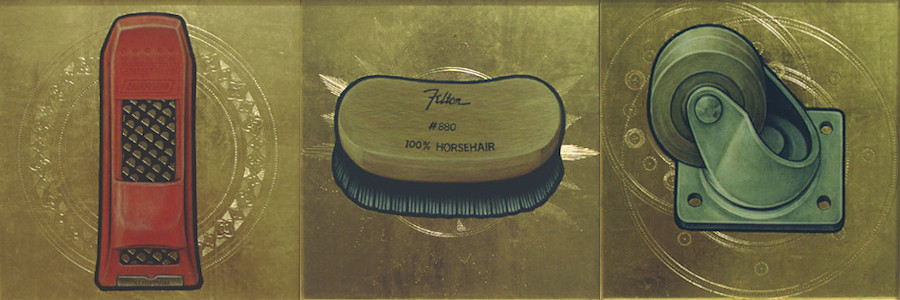
"Stop, Caution, Walk" by Kenji Kojima
Egg Tempera, Gold Leaf on Panel. 10x10" Triptych, 1980
Kenji's Egg Tempera Paintings 1980-2004
I started my artist career in 1980
The Latest Artworks, Nov.-Dec.2025
Expand the Video to Full Screen
21st-Century Pop & Mannerism of AI Image
The Great Wave Cup After HOKUSAI / 1:30 /2025
No other art is as popular with the masses as a painting printed on a cup.
Binary Interpretation The 129,600 Pixel Colors
Ragaraja / 4:00 / 2025
Binary Interpretation The 162,000 Pixel Colors
Thunder God & Wind God / 4:50 / 2025
Binary Interpretation The 100,284 Pixel Colors
Flag: After Japser Jones / 5:00 / 2025
Binary Interpretation The 90,000 Pixel Colors
PEEL SLOWLY AND SEE: After Andy Warhol / 4:00 / 2025
2025 - 2024
Exhibitions & Media Art Festivals
AI Art Talk Podcast Kenji Kojima's
The Experiment of the Period of Great Change.

Participating in Media Art Festivals
• Internationales Digitalkunst Festival 2025,
Stuttgart, Germany, November 8, 14 & 28, 2025
• ON SCREEN 2025 Festival SEASON 03: from September 21, 2025
Dialogues with the Machine / Co-Creation & Critique
SEASON 01: July 24, 2025 - Season 07: November 20, 2025
AI Art Talk Podcast:
It covers two projects
Binary Interpretation of Paul Gauguin,
Vincent van Gogh in Arles and Lascaux
Transcription:
https://kenjikojima.com/indexBinaryArt.html
|
New Value Created by Technology: Kenji Kojima explores the intersection of perception, digital data, and media through works like RGB MusicLab, which converts images into sound, and encryption-based projects using one-time pad principles. His art often involves encoding images into unreadable mosaics using XOR operations, only reversible with the correct key. Kojima sees this process as a metaphor for human perception—extracting meaning from chaos. Kojima believes that “NFT art” is not art but a financial product. The true power of digital art lies in its ability to cross the boundary between uniqueness and reproducibility. If a real artwork could be copied infinitely, its monetary value would dissolve — yet its aesthetic or spiritual value could persist. Kojima’s work seeks to restore art beyond the financial boundaries of capitalism, reviving a direct connection between the artwork and the viewer. One of the primary causes of environmental degradation is the insatiable greed driven by materialism. Art has been confined within the boundaries of economic value and the cult of the singular object. To restore balance, art must step beyond this artificial line and rediscover its role in redefining human values. The restoration of art’s true boundary — between matter and spirit, value and meaning — may become the first step toward a renewed civilization. |
"AI Art Talk Podcast: Kenji Kojima's"
is selected for ON SCREEN 2025 Festival
SEASON 03: from September 21, 2025
Dialogues with the Machine / Co-Creation & Critique
SEASON 01: July 24, 2025 - Season 07: November 20, 2025
Vienna, Austria
Begins with Chaos - Lascaux

The Ras Al Khaimah Contemporary Art Biennale
"Civilizations: Under the Same Sky"
January 16 - February 15, 2026
Emirate of Ras Al Khaimah, United Arab Emirates
The Wrong Biennale / anything but this
November 1, 2025 - March 31, 2026
FILE (Festival Internacional de Linguagem Eletrônica) 2025
7/16/2025 - 9/7/2025, São Paulo, Brazil



Rencontres Internationales Traverse
Toulouse, France on March 12 - 16, 2025
the Cusco International Video Art Festival
Casa de la Cultura de San Sebastián, Peru
November 25, 26, and 27, 2024
FONLAD 2024
Online: October 1 - 30, 2024
Screening: October 19, 2024
Pátio da Inquisição - Visual Arts Center, Coimbra, Portugal
Technocene Berlin Templehof
July 5 - July 7, 2024
DIGITAL VIDEO ART INTERNATIONAL STREAMING FESTIVAL
PREMIERE SEASON 3 & PREMIERE SEASON 5
Vienna, Austria, Begins July 11, 2024
IDKF (Internationales Digitalkunst Festival)
November 2024, Stuttgart, Germany
"Oto Zono" Electro-Acoustic Sound Festival + Visuals
November 30 & December 1, 2024, New York
OPEN NIGHTS festival Vol.10
in Thessaly and Larissa, Greece
From the End of Summer to Fall 2025
This Planet is Our Home / Stream

Noh Dance Prelude by Uemura Shoen
"Oto Zono" Electro-Acoustic Sound Festival + Visuals
at HEART, SOHO, New York
November 30 & December 1, 2024,

Profusion of Colors
at A.E. CORNER, Tirano, Italy
October 10 - 24, 2024
Da Vinci Code / Ginevra de' Benci

Spring 2025, Media Wall
University of Mary Washington, Virginia
This Planet is Our Home.
December 2024 - January 2025
TAA OPEN CALL
The Art Association, Genève, Swiss.
May - September 2024
Participation in "Open Media Art"
in a public space in Košice, Slovakia.
July 17 - September 27, 2024
"Ripples" Organized by the New Media Art Space
at Baruch College in New York.
This Planet is Our Home.
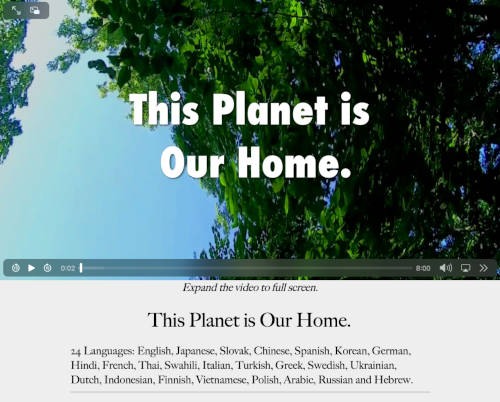
Download the Free Material Green Back


Create your "This Planet is Our Home."
The Art Alive Festival
Canelas, Estarreja, Portugal
April 2025
Selected for The Anthropocene Project
of The New Museum of Networked Art
May 2024
Anthropocene, Spaceship Earth, Bee

ALL STREET GALLERY NEW YORK Online Solo Show
March 1 - 31, 2024
Project:
Bitwise Splitting and Merging of Pixels
A Sunday Afternoon on the Island of La Grande Jatte

XXVIIe Rencontres Internationales Traverse
Toulouse, France on March 5 - March 19, 2024
Screening Kenji Kojima's Video at Les Abattoirs, musée d'art moderne et contemporain
Split and Merge Pixels Bit by Bit
Wheat Field with Cypresses Ver3
Online Press Photos & Read Headlines / 4:30
Participating in the Anti-Nuclear Art Exhibition
March 11 - May 25, 2024
at Rabbit House 41 Essex St. New York
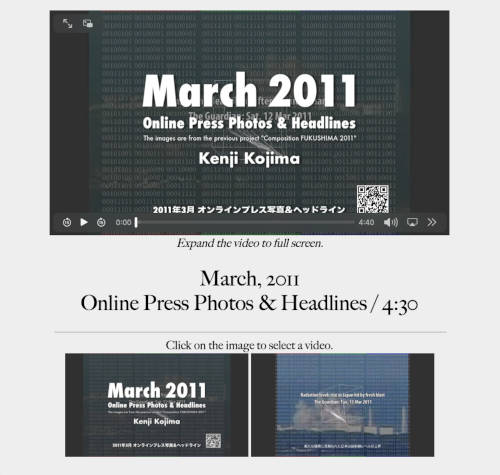
2025 Publication
Superpresent / A Magazine of the Arts
Winter 2025

Page 37 (PDF), Page 65 (Magazine)
New Projects in 2025
Project: Contemplates Human Existence and Nature

Project: AI Art Talk Podcast Kenji Kojima's
The Experiment of the Period of Great Change.

Project: ZEN WALK
Project:
Binary Interpretation of
Early Development Photography

Project:
Binary Interpretation of
the Arles period of Van Gogh and Gauguin

This Planet is Our Home 2 minutes Silent

Encrypt & Decrypt Magura Cave Murals

Projects in 2024
Project / Bitwise Splitting and Merging of Pixels
Decode(Chaos) Portraits by Leonardo da Vinci

Project / Bitwise Splitting and Merging of Pixels
Uemura Shoen
Noh Dance Prelude / Mother and Child

Anti-Nuke Video Art
PIKA DON

Project / Bitwise Splitting and Merging of Pixels
Encryption by Music Key
Da Vinci Code / Ginevra de' Benci
Da Vinci Code / Mona Lisa
Da Vinci Code / The Lady with an Ermine

The Rockets Make the Planet Cry
with Subtitles in Five Languages

This Planet is Our Home.
24 Languages

Project 2024 - 2023
Bitwise Splitting and Merging of Pixels
Project 2024
Bitwise Splitting and Merging of Pixels
The Good Samaritan / Laocoön


Bee Dances / Buzzin' Bees, 2024
Climate Messages from Rap, Aria and Reggae

Copy It, Share It. 2024 - 2025
Micky Mouse "Steamboat Willie" in the Public Domain Now!

You can donate any amount to the artist
if you approve of the video as art.
|
CC BY 4.0 DEED Attribution 4.0 International under Creative Commons License. |
 Click and Go to PayPal Click and Go to PayPalPlease Support Kenji Kojima's Artworks from as little as $1 - It only takes a minute. Email: index@kenjikojima.com 日本からのドネーションは こちらをクリック 日本から任意の金額のドネーションはできません。 金額を選んでご寄付ください。 Eメール: index@kenjikojima.com |
|
|---|---|---|
Project 2023
Six Musical Compositions Created from
the Color Elements of Edgar Degas' Pastel Works. 2023

Project
"Bitwise Splitting and Merging Pixels"




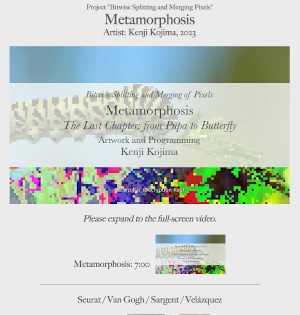
Project
"The Musical Interpretation of Movies & Photographs by Binary"


Project
"The Interpretation of Painting by Binary"
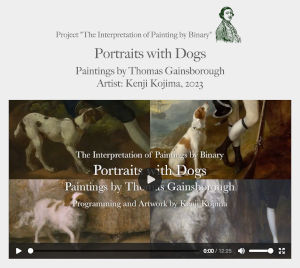

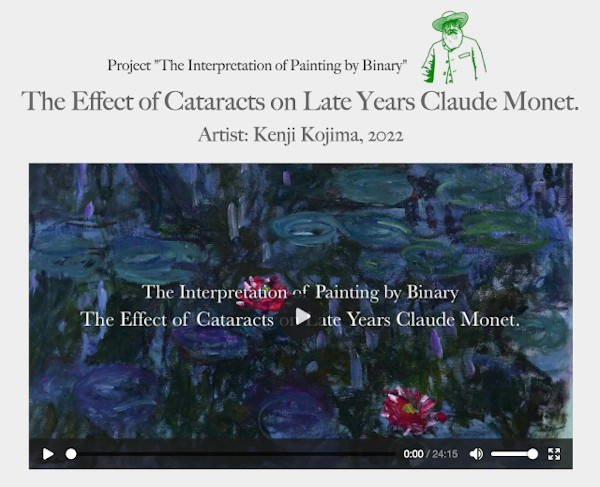

Project 2023
 kenjikojimany/Icon Drawings
kenjikojimany/Icon Drawings
Project Site
One Dollar Bill Delusions
Morphing 57 Portrait Icons
Exhibitions & Media Art Festivals in 2023
July 22 - September 9, 2023, Torrance Art Museum, Los Angeles
Vacations in the Subconscious
Participate Project in the Exhibition
One Dollar Bill Delusions
Toulouse, France on March 15 - April 2, 2023
XXVIe Rencontres Internationales Traverse


|
What Madame Cézanne was thinking.
2023 Exhibition Catalog
April 20 - September 28, 2023, BROWARD College, Weston, Florida
South Campus Art Gallery
THE ELASTIC MIND

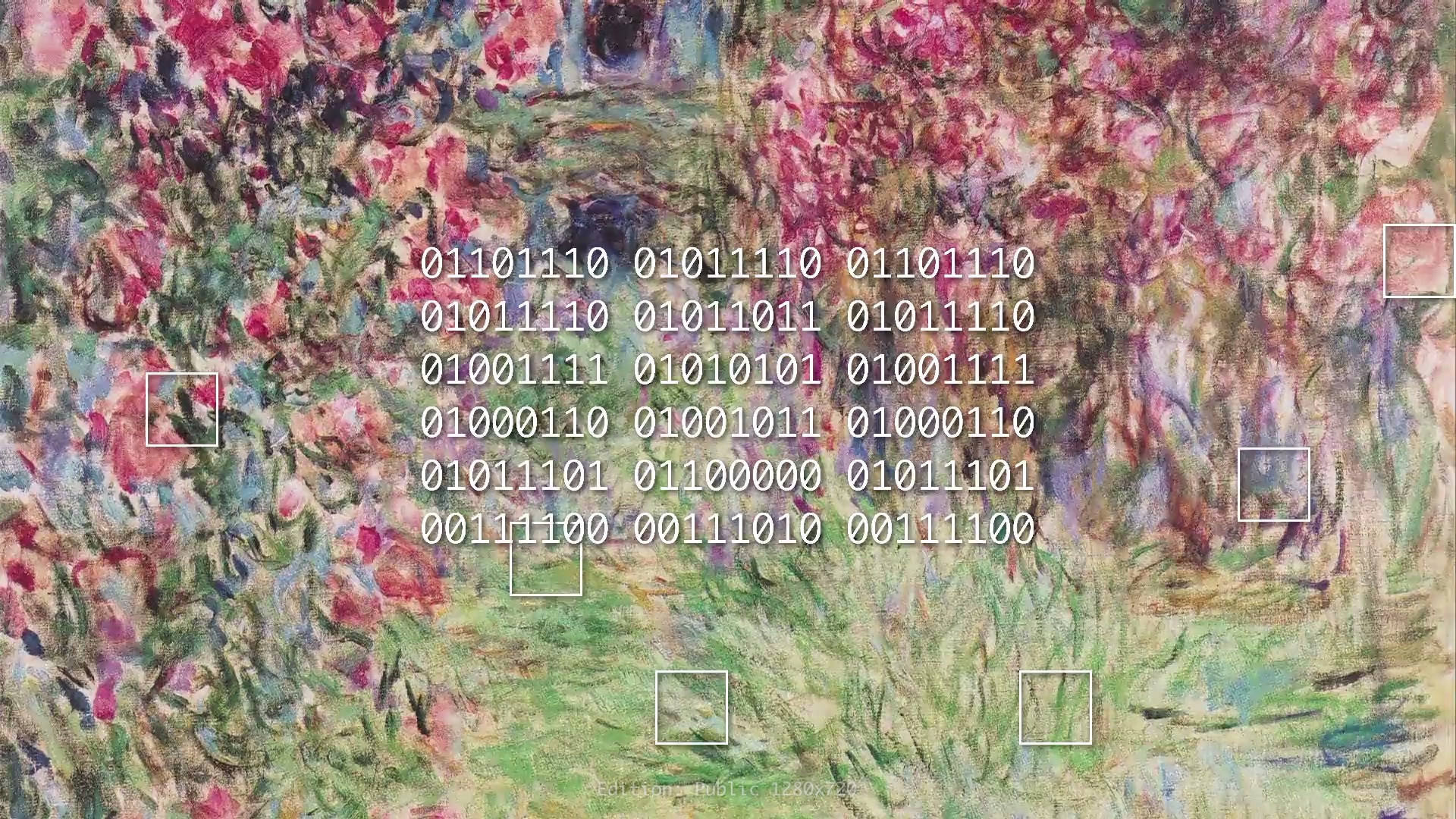
Instagram Exhibition View
The Effect of Cataracts on Late Years Claude Monet.
July 4 - August 28, 2023, São Paulo, ,Brazil
FILE "Electronic Language International Festival" 2023


|
The Effect of Cataracts on Late Years Claude Monet.
& What Madame Cézanne was thinking.
Participated in Group Show in 2023
SOJOURNER INAUGURAL JURIED EXHIBITION
446 West 34th Street, 4th Floor, New York, NY
Exhibition: February 9 to March 15, 2023

2022
The Musical Interpretation of Classic Paintings by Binary
2015 - 2021
Techno Synesthesia:
Bees, Birds, Speech, Lumière and Other Series
2014 - 2018
Four Seasons Studies, Space-Time Drawing
Archway, Fountain in New York City
Subway, Street, Others and Studies
Media Performance Noh [I-MY]
Anti-Nuclear Artwork
Composition FUKUSHIMA 2011
Created music from press photos on internet
RGB Music 2007 - 2019
The application develpoment
which converted image data to musical notes
Cipher 2013, 2014, 2016
Cipher Music / Split & Merge AudioVisual
CipherText Project / 暗号計画
Encrypt Image / 暗号画像
Web Applications English & Japanese
時間系不定時報
JIKANKEI “FUJYO JIHOU” 2002 - 2012
The Sun goes around on Spaceship Earth.
JIKANKEI is a software art. It displays angles of the Sun
and local times of cities and places on the Earth.
2014 -
News / Exhibitions in Cyber and Real World
LiveCode 6 Programming Tutorilal (Japanese)
LiveCode 6 プログラミング初心者開発入門 (日本語)
1つのソース・コードから Mac, Win, Linux アプリを同時に作成する
about Techno Synesthesia in Japanese by the artist Kenji Kojima.
シナステージア(共感覚)とテクノロジーによる
相互拡張感覚のアートについて:小島健治
KENJIKOJIMA.COM / INDEX 1997 - 2016
Download Kenji Kojima's Free Apps

Attribution-NonCommercial-NoDerivatives
You Can Download Kenji Kojima's Online Edition Videos
(Public 1280x720) under Creative Commons License
オンライン版ビデオ(Public 1280x720)は
CCライセンスの下ダウンロード自由です。商業利用はできません。
Email: index@kenjikojima.com